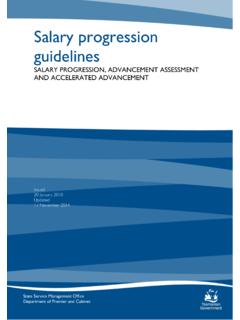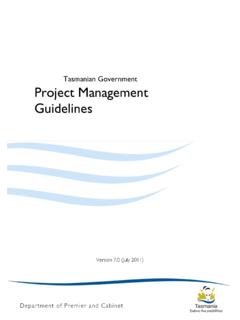Transcription of Tasmanian Adventure Activity Standard
1 Draft B 14 June 2007 Version 1 June 2009 Tasmanian Adventure Activity Standard Risk Management Planning (Supplementary Folder) Advice for Organisations, Guides and Leaders Tasmanian AAS Supplementary Folder Risk Management Final 16 06 09 V1 Page 2 Adventure Activity standards TABLE OF CONTENTS Introduction .. 3 Understand the Operational Context .. 3 The Role of Risk .. 3 What is Risk? .. 3 Risk-Management Planning .. 4 What are the Risks?.. 4 Assessing the Risks .. 5 Developing Risk Mitigation Strategies .. 5 Conclusion .. 6 References .. 6 Tasmanian Adventure Activity Standard Risk Management Planning Drafted by Tony McKenny for Sport and Recreation Tasmania Endorsed by Tasmania s outdoor recreation and Adventure tourism sectors Supported by the Tasmanian Government Tasmanian AAS Supplementary Folder Risk Management Final 16 06 09 V1 Page 3 The following supplementary information has been provided as part of the Tasmanian Adventure Activity standards .
2 It is not intended to be comprehensive in content but includes additional background information on key aspects of planning and useful references for further reading. Introduction Most community groups and commercial organisations will already have some protocols for dealing with risk even if they are not formalised into a plan . The following information will enable an analysis to be made of how well risk is being managed for an Activity and whether a formal plan is needed. Good risk management is essential for a successful Activity . It will reduce the likelihood of loss, damage, injury or death. A good risk management plan provides: confidence that all foreseeable risks have been identified and mitigated confidence that an appropriate duty and Standard of care will be applied a document that clearly outlines the strategies that will manage the identified risks.
3 Understand the Operational Context Understanding the context is an important step in the risk-management process. It is the context that determines the level of acceptable risk and the Standard and duty-of-care. It is important to: understand the industry and community expectations of the Activity being planned know the technical requirements for the activities involved have suitable knowledge and experience in those activities have a good understanding of the level of risk to which participants should be exposed. The Role of Risk There are many outdoor Adventure pursuits where great reward can be obtained from exposure to risk. Many people, though, perceive risk only in terms of potential loss rather than gain. Risk does have a positive side.
4 Well managed Adventure activities use the concept of perceived versus real risk. Those with little knowledge of an Activity may perceive it as dangerous (high perceived risk), whereas through the application of suitable knowledge, skill, and experience, another person can reduce the real risk to acceptable levels (low real risk). In other words the participants perceive high risk but the real risk they are exposed to is low. Risk to this extent is thus defined by the individual. What is Risk? The Australian Standard , Risk Management AS/NZS 4360 1999 defines risk as: The chance of something happening which will impact on objectives. It is measured in terms of consequence and likelihood.
5 Tasmanian AAS Supplementary Folder Risk Management Final 16 06 09 V1 Page 4 In other words: what can happen? What is the likelihood of it happening? What will the consequences be if it does? Two other related words also need some definition: A hazard is something with the potential to cause harm. A hazard alone though does not constitute a risk: there must also be something at risk. Safety and risk are inversely proportional. If safety is reduced, risk increases and vice versa. It is useful to remember that perceptions of risk change depending on which word is used - risk or safety. For example, a safety manual sounds more positive than a risk-management manual. Risk Management Planning To exist is to be exposed to risk. Perfect safety is unattainable.
6 However, whilst it may not be possible to have a risk-free environment, it is possible to manage risk to a large extent. The standards Australia publication Managing Risk in Sport & Recreation HB 246 2002 defines risk management as: The systematic application of management policies, procedures and practices to the task of identifying, analysing, evaluating, treating and monitoring risk A risk management plan generally comprises the following: an overview of the Activity aims, people, location, time and so on a register of the risks identified evidence that a consistent process has been applied to assess the risks the mitigation strategies any supporting information. What are the Risks? Outdoor activities can be exposed to a wide range of risks.
7 Things at risk may include people, equipment, the environment, relationships or even intangibles such as goodwill and reputation. Identifying the risks requires a mix of knowledge, experience and lateral thinking. Each Activity will have a unique set of risks because of differing goals, environments, people and relationships. There are many ways to identify risks. Existing information, in the form of policies, guidelines, rules, checklists, accident reports and, most importantly, people are all potential sources of information. Those with a sound understanding and a lot of experience in the Activity and the organisation are often best placed to identify the risks. Brainstorming with a small focus group, aided by simple checklists, can be an effective way to identify risks.
8 It is important to remember that a risk comprises three parts; a source, something at risk, and a consequence. It helps to identify each risk by starting with the words There is a risk . For example: There is a risk that a paddler will capsize, be unable to exit the kayak and drown. Tasmanian AAS Supplementary Folder Risk Management Final 16 06 09 V1 Page 5 The checklist included below groups sources of risk by the asset or thing at risk and is useful to prompt thinking about the risks to which the Activity may be exposed. Rather than a process of completely random identification, it is wise and efficient to channel thinking in particular areas and work through the Activity chronologically. Assessing the risks Assessing the risk is a two part process.
9 The first part is that of analysis What is the level of risk? The level of risk is a product of the likelihood of the risk occurring and the consequences. The table for qualitatively determining the level of risk (Risk Identification Check List, below) is a useful tool for this. The second is the evaluation. Having determined the level of risk so what is next? This is where the second part of the process the evaluation - comes in. Is the level of risk acceptable? This is the most important question. What is acceptable in terms of likelihood? What are acceptable consequences? Considering these questions can help with the development of mitigation strategies. Aspects such as existing management strategies and the degree of risk borne by others also need to be considered as part of the evaluation process.
10 Developing Risk Mitigation Strategies The risk management process identifies five ways of treating risk. Risk can be avoided, reduced, transferred, financed, accepted or a combination of any of the above. Some ways may be better than others and there are advantages and disadvantages to them all. In reality though, most of what is done to mitigate risk revolves around reducing the risk. Some ways of reducing risk are better, more reliable and perhaps more acceptable than others. There are two simple hierarchies shown below which should be considered. Most desirable What can I do to prevent the risk? (likelihood) Can the risk be eliminated? Can a safer alternative be substituted? What can I do to prepare for or respond to the risk?








